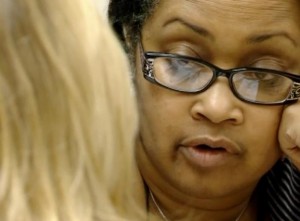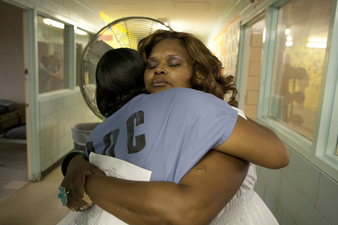Social Workers Review “Prostitution: Leaving the Life”
The Oprah Winfrey Network gave SocialWorkersSpeak.org an advance copy of “Prostitution: Leaving the Life,” a 90-minute documentary that will air Aug. 18 at 9 p.m.
The documentary follows inmates and staff at a Cook County Jail Chicago mentoring program that helps women escape from prostitution. Most of the women featured in the film grappled with sexual abuse or drug addiction.
Social workers who watched the program were Patricia O’Brien, MSW, PhD, associate professor at University of Illinois at Chicago Jane Addams College of Social Work and Bekki Ow-Arhus, MSW, LICSW,ACSW, DCSW, and Kamilah Omari, MSW, ACSW, senior practice associates at the National Association of Social Workers in Washington, D.C.
O’Brien has a special perspective — she has been involved with Women’s Justice Services at the Cook County Jail for some time and is helping to start a co-parenting program for inmates.
Q: Did you think the documentary was educational? Did you like or dislike the film?
O’BRIEN: The statistics and information about who gets involved in prostitution and its impact is certainly educational, especially for social workers who have not recognized the problem. One of the most powerful points is that what defines prostitution is much broader than might be usually considered – thus, sex traded for drugs, sex in the context of an abusive relationship, sex for survival on the streets could all be considered prostitution if the demand is evident for it. The film provides a very authentic picture of the struggle that women have with both addiction and survival on the streets and the hard choices they face in recovery. I would certainly use the film in classes that can help students understand some of the complications that women face in dealing with prostitution and drug addiction.
OW-ARHUS: The program had a good, clear depiction of the problems and issues women face in drug and alcohol treatment and in jail. But it’s not good for training on social work skills since no social workers were identified and the approach of the peer counselors and clinical ward did not appear to be social work practice in theory or approach.
OMARI: Overall, I disliked the film. However, I’m uncertain if the aspects of the film that I disliked were related to the actual women’s program or the filmmaker’s novice approach to the subject matter. For example, it never becomes abundantly clear ‘what’ help in the women’s program actually involves. It is clear that the filmmakers didn’t challenge any of the stereotypical thought processes or underlying sexist attitudes regarding the criminalization of women charged with and involved with prostitution. Further, the filmmakers failed to properly address the subject of minors being victims of commercial sexual exploitation. This, specifically, was a huge fail.

Marian Hatcher, a former prostitute and drug addict who now counsels women at the Cook County Jail. Image from "Prostitution: Leaving the Life."
Q: Do social workers take part in programs such as the one depicted in the OWN documentary?
O’BRIEN: There is really nothing that would prevent social workers from working at such programs, especially to provide assessment, counseling, group facilitation, case management, parenting skills and family linkage. I know that there is no social worker currently employed at the Women’s Justice Services; they have generally preferred psychologists and psychiatrists (by contract) in part because the women are screened for mental health disorders and medication. In our project, our research project coordinator is a clinician and she will be supervising MSW interns at the program. Perhaps that will open the door to other social workers being employed there.
Q: If you could what would you change in the film?
OW-ARHUS: I would have identified the background of the clinical supervisor shown in the documentary and other professionals at the group staffing and case review meetings. I would have also been more transparent about the treatment approach by identifying it clearly. And perhaps narrow the focus to two or three case scenarios that differ signficiantly to show the range. I would have also focused a bit less on the peer coordinators, although their role is important. It would also have been nice to add in information about the connection between the peer coordinators and how they are supervised, and the checks and balances with other professionals to make the team work.
OMARI: I would reframe the narrative surrounding the stories of the young women Anesha and Jamisha. These young women, were presented as though they were adults entering into prostitution when, in fact, they were minors. They were victims of commercial sexual exploitation. It is a deleterious suggestion that a minor, who can’t legally consent to sex, can ‘choose’ to enter prostitution.
O’BRIEN: From a social work perspective, I think it would be helpful to know more clearly what the “treatment” is. We get a sense, particularly at the engagement level, that if you haven’t “been there,” there isn’t much you can say or do to join with women who have been on the streets. Also, though there is the example of the woman who has been using heroin who connects her drug use with sex acts, it’s hard to see the connection between drug use and prostitution (though I know that no one is eligible for the Women’s Justice Services unless they have a drug charge).
Q: Would you recommend other social workers or the public watch the film?
OW-ARHUS: Social workers not so much but for the public, yes. However I wish it made a clear connection about the professionals that one might reach out to. Not everyone needing treatment for prostitution and drug and abuse issues accesses help from prison. How can women outside of jail get help? That was an essential piece missing.
OMARI: No, for a professional, I don’t think the film adds any compassion or humanity to the women featured in the film or the subject of prostitution. Nor do I think this film was done well enough to educate the public. And because of the subject matter, I don’t think this film could be considered entertainment. I think the filmmakers should have spent more time exploring their personal narratives.
Q: Ms. O’Brien, what can the public do to help women escape prostitution?
O’BRIEN: Though this film does not address this directly (except in the GED class), women like men, need access to legitimate income to build their self-sufficiency and support their children. It is also true that as a society, we need to take seriously the work of community-based accountability and restorative practices that can facilitate people having the capacity to rebuild their lives after being charged with offenses.
In July SocialWorkersSpeak.org already interviewed Marian Hatcher, one of the counselors from the Cook County Jail who took part in the documentary “Prostitution: Leaving the Life.” To read that interview click here.
Social workers also help women overcome challenges that could lead to prostitution, including domestic violence, human trafficking and addictions. To learn more visit the National Association of Social Workers Peace and Social Justice Web pages, which include a section on human trafficking, by clicking here; the NASW “Help Starts Here” Web pages on domestic violence by clicking here; and the “Help Starts Here” Addictions Web page by clicking here.
| Leave A CommentAdvertisement
1 Comment
Leave a Comment
You must be logged in to post a comment.




Great film. Yes, while there were many questions, it allowed us to see the need for more programs like this. For us to identify victims of child abuse & aid them before the damage done 2 them in childhood leads to roads of addiction/prostitution, etc.,
It would be good to see follow ups in the hopes that the program is continually financed. And, to see how the counselors are progressing in their journey. Great film